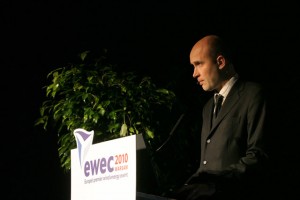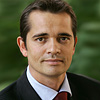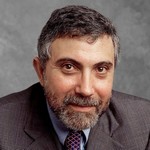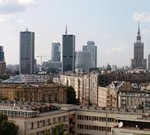 Polish Under-Secretary of State, Marcin Korolec, told the European Wind Energy Conference (EWEC) in Warsaw that his country plans an “intensive development” of wind energy both on land and at sea. Poland has “optimal” weather conditions for wind energy, in particular the Baltic sea shore, and open terrain and mountains in the south of the country.
Polish Under-Secretary of State, Marcin Korolec, told the European Wind Energy Conference (EWEC) in Warsaw that his country plans an “intensive development” of wind energy both on land and at sea. Poland has “optimal” weather conditions for wind energy, in particular the Baltic sea shore, and open terrain and mountains in the south of the country.
However, Jaroslaw Mroczek, President of the Polish Wind Energy Association struck a more cautious note saying that while Europe is doing well on renewables, Poland is not necessarily on the right track. Plans for renewables “look wonderful”, Mroczek, said, but stronger political will and new legislation is needed.
Korolec told the audience – which included delegates that had traveled overland from places as far and wide as Helsinki and Madrid – that wind will play a “very important element of the total electricity production” in a country that is currently powered by over 90% coal.
EWEC’s first session opened with some live musical entertainment and dancers. Christian Kjaer described this year’s delegates as the “most committed” to wind energy for their efforts to get to Warsaw as flights remain grounded across large swathes of the continent.
Around over 1,900 participants have made it to EWEC and more are expected to arrive tomorrow.
 European governments, the European Commission and the European Parliament have begun discussions on how the European energy system should look like in 2050. It is clear that political actions are needed this decade to prepare for such a dramatic overhaul of our energy supply structure.
European governments, the European Commission and the European Parliament have begun discussions on how the European energy system should look like in 2050. It is clear that political actions are needed this decade to prepare for such a dramatic overhaul of our energy supply structure.
The EU and the G8 have agreed to cut emissions by 80% in 2050, with the EU saying it will deepen cuts to 95% if other countries sign up to similar action. These commitments mean that the power sector will need to be 100% carbon free by 2050, since transport and agriculture will need the residual 20% emissions.
Power plants have a long lifetime and, if we are to keep to the 2050 limit, this means that no carbon emitting power plant can be constructed in the European Union after 2020.
The first question to any responsible politician – European or from any other industrialised country – talking about 80% greenhouse gas emissions reductions by 2050 must be: What measures do you propose to ensure that no carbon emitting power plant is constructed after 2020?
Many stakeholders will – and are – pushing for a combination of renewable energy, nuclear energy and carbon capture and storage (CCS) to achieve zero-carbon power by 2050. They will argue that we need all technologies to decarbonise our power sector. It is not correct that we need them all to achieve a carbon free power sector in 2050. Renewable energy can do it alone with a massive contribution from onshore and offshore wind energy.
“Renewable energy can do it alone with a massive contribution from wind energy.”
In 2000, 21% of new power capacity installed in the EU was from renewable energy technologies (19% was wind energy). In 2009, the share had increased to 62% (39% wind). In the past ten years, the EU increased renewable energy’s share of new power capacity by 40%-points to 61%. There are no fundamental technical barriers to fill the remaining 39% gap and source all our new power capacity from renewables by 2020.
The wind energy sector should make a loud and clear statement in the current energy debate about 2050 that we do not need 100% zero-carbon (meaning a combination of renewables, nuclear energy and coal CCS) by 2050. We need 100% renewable energy by 2020.
It’s always refreshing to read a well thought out review of an essential public policy matter that has become somewhat derailed by powerful self interests which —surprise, surprise — want nothing to come between them and the raw pursuit of money. In a 10-page article in The New York Times Magazine, published 11 April, Paul Krugman argues that a green economy that drastically reduces greenhouse gas emissions can and should be built — now.
Krugman, an NYT columnist, professor at Princeton and the winner of the 2008 Nobel Prize in Economics, writes that the risk of planetary catastrophe from global warming requires a strong and almost immediate climate policy. In his article, called Green Economics: How We Can Afford To Tackle Climate Change, Krugman notes that climate scientists suggest society has to wean itself off coal and other fossil fuels in order to avoid an apocalypse caused by soaring temperatures.
 “The truth is that there is no credible research suggesting that taking strong action on climate change is beyond the economy’s capacity,” Krugman says, adding that if the US and Europe got serious about dealing with global warming the rest of the world would likely join in the effort.
“The truth is that there is no credible research suggesting that taking strong action on climate change is beyond the economy’s capacity,” Krugman says, adding that if the US and Europe got serious about dealing with global warming the rest of the world would likely join in the effort.
Reviewing scientific and economic literature, he makes the case for dealing aggressively with climate change now by pointing out that some data suggests unchecked global warming could lower gross world product by 5% in 2100, whereas stopping it might cost only 2%.
“We know how to limit greenhouse gas emissions. We have a good sense of the costs — and they’re manageable. All we need now is the political will,” concludes Krugman.
His persuasive, methodical argument is a welcome tonic — especially after climate change sceptics have increased their influence since Copenhagen and the leaked (or hacked) e-mails scandal — and it will no doubt be well received by people attending this month’s European Wind Energy Conference in Warsaw.
Welcome to EWEA’s freshly launched blog.
 Starting live from the European Wind Energy Conference and Exhibition (EWEC) in Warsaw, Poland this week, we’ll kick off by bringing you news from where the action is at Europe’s top wind energy event. Despite the chaos caused by the volcanic ash cloud still shrouding Europe, many delegates have made their way to Warsaw and EWEA staff are all onsite making sure the event runs smoothly. For those unable to make it, the conference website is providing live streaming of most conference sessions.
Starting live from the European Wind Energy Conference and Exhibition (EWEC) in Warsaw, Poland this week, we’ll kick off by bringing you news from where the action is at Europe’s top wind energy event. Despite the chaos caused by the volcanic ash cloud still shrouding Europe, many delegates have made their way to Warsaw and EWEA staff are all onsite making sure the event runs smoothly. For those unable to make it, the conference website is providing live streaming of most conference sessions.
This blog will provide conference updates throughout the event. Expect to read what leading wind energy professionals are talking about at Europe’s premier annual wind event. Topics covered range from looking forward to Europe’s energy supply in 2050 and the goal of achieving 100% renewables in the power sector by then, to the latest turbine technology.
EWEA’s 2010-2011 campaign, a breath of fresh air, will be launched at EWEC. With fun, interactive tools for delegates and visitors to use to show their support for wind energy, EWEC2010 promises to be an entertaining and interesting event.
Check back here soon for more…
 Polish Under-Secretary of State, Marcin Korolec, told the European Wind Energy Conference (EWEC) in Warsaw that his country plans an “intensive development” of wind energy both on land and at sea. Poland has “optimal” weather conditions for wind energy, in particular the Baltic sea shore, and open terrain and mountains in the south of the country.
Polish Under-Secretary of State, Marcin Korolec, told the European Wind Energy Conference (EWEC) in Warsaw that his country plans an “intensive development” of wind energy both on land and at sea. Poland has “optimal” weather conditions for wind energy, in particular the Baltic sea shore, and open terrain and mountains in the south of the country.






 Comments
Comments


